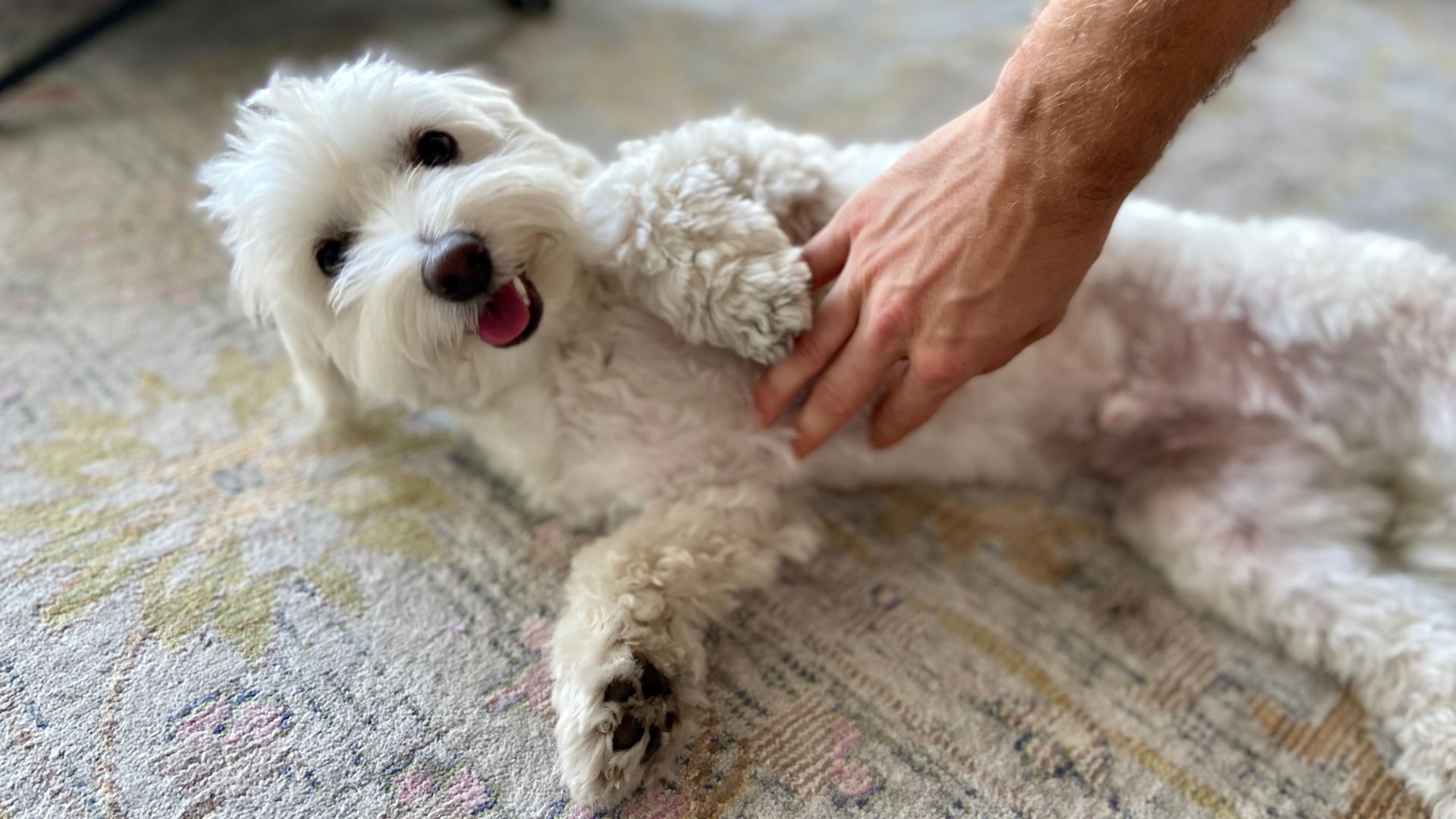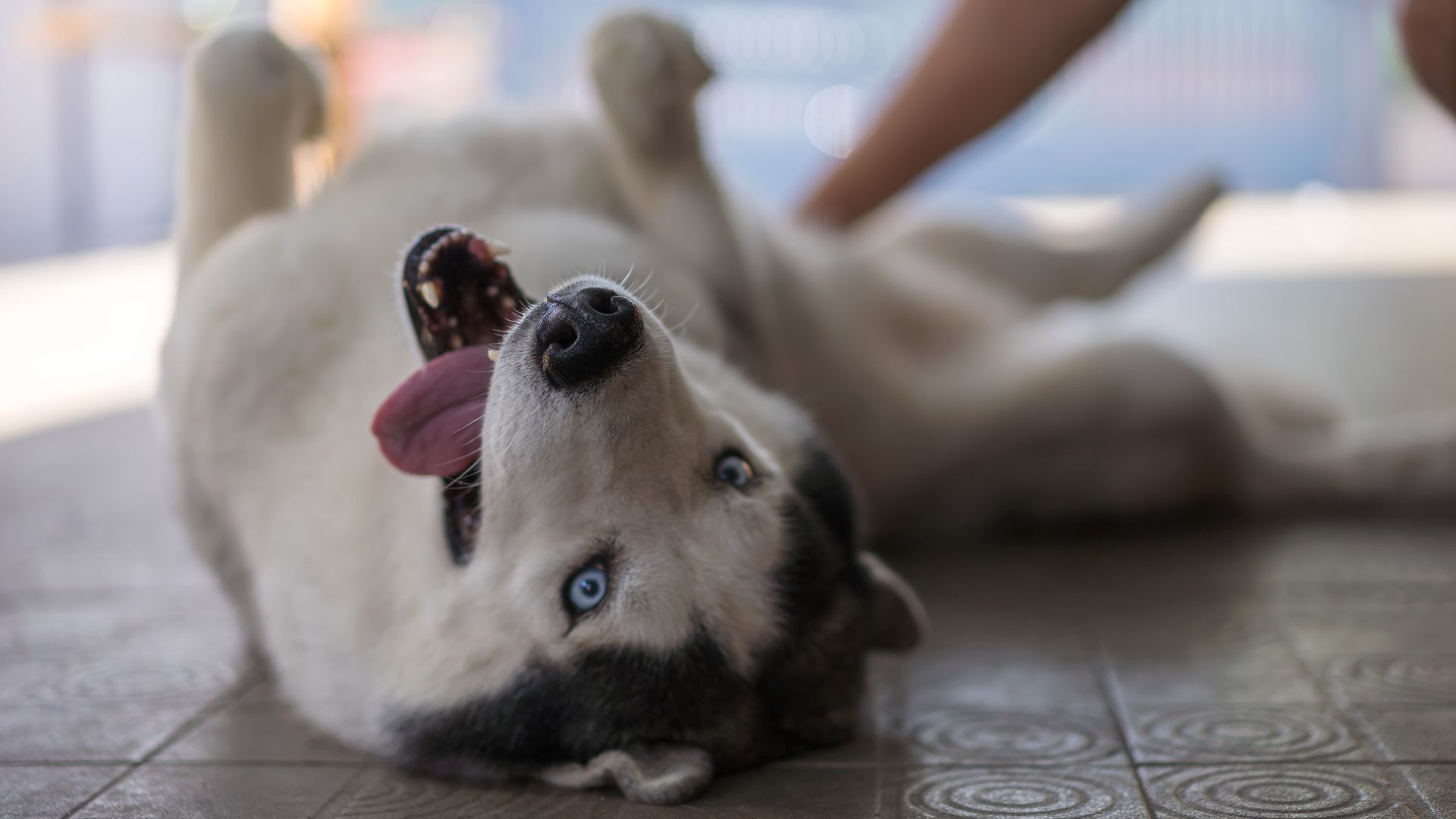
As you gently rub your dog's tummy, the look of glee on his face and all four legs in the air suggests he's loving the attention. But why? Why do dogs love belly rubs? If you've ever pondered on this question, read on to learn the answer to the great mystery of our furry friends.
As a qualified behaviorist and a lifelong dog lover and owner, I've tickled a lot of dogs' tummies. Every dog I have shared my life with has loved getting a belly rub, though I've met some dogs who prefer no tummy rubs.
In most cases, when a dog trusts you, flopping over onto its back for a tummy tickle almost seems like an involuntary response to human touch. You might notice your furry friend's open-mouthed "smile", lolling tongue and wagging tail. If you stop scratching your doggo’s tummy, he may paw your hand to continue.
When a dog exposes its tummy, it can be a submissive gesture. For example, when two dogs play together, the more submissive dog may roll onto its back as an appeasement gesture to diffuse potential aggression from the dominant dog.
Sometimes, it's a playful gesture during play, often accompanied by rolling on the ground and expressing a soft, huffing sound that sounds like "hah-hah-hah." That's a sign of a happy woofer.
Recognizing the difference between a submissive gesture and an appeal for a tummy rub is crucial.
Tickling the submissive dog's tummy could trigger more nervous behavior. In those instances, it's preferable to build the dog's confidence and gain his trust by offering a yummy treat. Wait until he stands up, then offer him something delicious, like one of the longest-lasting dog chews.
Note: Avoid giving a dog treat when he displays nervousness, as that can reinforce the behavior.
So, if you've ever wondered, "Why do dogs like belly rubs?" this article is a peek into the weird and wonderful world of belly rubbing for our furry friends.
Why do dogs like having their belly rubbed?
Dogs can roll on the grass or carpet to scratch those hard-to-reach areas on their back. They can scratch most parts of their bodies but not their tummies. So, it's a real treat when their human friends offer this service for free.
My dog, Poppy, used to love rolling on the freshly made bed in the morning. For her, it was heaven when I joined in with her frolicking and took care of the "essential" belly rubs.
Do belly rubs mean a dog trusts you?
Yes, absolutely. When a dog allows or invites you to rub his belly, it's a sign that your loving fluffball feels safe and comfortable exposing his soft underbelly to you.
When you bring a new dog into your home, it may take a few weeks before he trusts he is part of the family. The more confident the dog, the sooner he will enjoy getting a belly rub.

How to understand if your dog wants a belly rub
My dogs sit next to me on the couch, and when I start stroking them, they almost immediately roll over, asking for a belly rub. These are the signs I notice as a dog lover and qualified behaviorist:
- Your dog rolls onto its back.
- The back legs hang loosely, exposing the tummy, and the front legs are bent.
- The body is relaxed.
- The mouth is usually open wide or in a kind of smile.
- Your dog may roll his head backwards
- Your woofer may squint his eyes, look at you or stare into space.
- The tail may wag furiously or a gentle, happy wag.
- Your dog may be silent, pant a little, or make the "hah-hah-hah" sound
How to understand if your dog does not want a belly rub
Not every dog wants a belly rub. New puppies or rescue dogs may show submissive behavior by rolling onto their back. A dog may be unsure if he is safe as he does not know you, so they offer an appeasement gesture to show they are not a threat.
The signs of a submissive gesture, not a belly rub request:
- The dog may freeze, have tense muscles or crouch.
- The jaw is tense. The mouth might be closed, or the lips pulled back in what looks like a grimace.
- You may notice the dog doing a lot of lip-licking.
- Wide eyes, staring away from you or squinted tightly. Very submissive dogs often show the white of their eyes. You may get the "side eye" where the dog looks at you without moving their head.
- The dog may whine or be quiet.
- If you try tickling the tummy, the legs and muscles stiffen.
Relaxed body language indicates that a dog feels comfortable with your actions. Avoid tummy rubs if the dog is tense and submissive until you have developed a bond of trust. Still unsure? Read our feature on dog body language to get to know your pup better.
How to give a great belly rub
Firstly, notice when your dog is relaxed, perhaps lying beside you or on one of the best dog beds. Your furry friend may enjoy a belly rub after a long walk or during a relaxing evening in front of the TV.
Start stroking your dog on the back or shoulder. Some dogs enjoy having their ears gently rubbed. Your dog may stir and roll over onto his back or raise a leg so you can sneak a hand onto his tummy.
Start rubbing the belly with the flat of your hand. Your dog may enjoy smooth strokes or prefer circular hand movements or gentle pats. Stop after a few minutes, rest your hand on his tummy and watch what your dog does next. If your dog paws you and relaxes into a more comfortable posture on his back, he's asking for more.
Every dog is different, so experiment with what your dog enjoys. My dog, Pepper, enjoys it when I slap her tummy gently. My dog, Luna, prefers I use two hands and rub her tummy playfully. They both display signs that they love this time together. Either way, our tummy rubs usually end up with a few zoomies around the hall!







